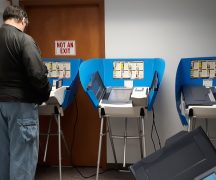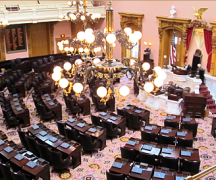Navigating a lapse between insurers and facing an $1,100 up-front cost he couldn’t afford, Marcus LaCour had no choice but to start rationing out the insulin he had left until his next paycheck came.
There’s no good or safe way for diabetics to cut corners taking their insulin, a hormone that regulates their blood sugar. It can cause a serious and lethal condition called diabetic ketoacidosis, acidifying people’s blood and dehydrating their bodies.
In an interview, LaCour called the three-week rationing stretch one of the hardest things he’s ever had to endure. He described the general hurt and leg pain he sensed when his blood sugar spiked, and how he tried exercising in a white-knuckled attempt to lower it.
Rationing essential medicine is an unthinkable situation for most Americans, but somewhat common among diabetics. A 2018 survey of 200 diabetics conducted by researchers with the Journal of American Medicine found one in four reported skimping on their doses due to drug costs.
Some 34 million Americans live with diabetes, many of whom are exposed to insulin costs that tripled between 2002 and 2013. List prices have risen since then too. For instance, a Novolog pen increased from $324 in 2013 to $558 in 2018, a 70% increase, according to a congressional investigation. These price spikes occur in a market for a lifetime illness that disproportionately affects poorer people and minority groups. Diabetes is the 7th leading cause of death in the U.S.
You’re either stuck trying to go to the ER to get it treated, or you try to make do. Which is the most unfortunate thing, because most people don’t survive if they’re trying to make do. You’re trying to ration what you have, or you’re feeling like you can’t eat. And because you can’t eat, you’re hungry. And at some point, it’s like, look, what am I gonna do? I’m not about to starve to death. But I know for a fact I don’t have any insulin either.
– Marcus LaCour
By his third week of rationing, LaCour said his boss wrote him a $250 check to help pay for his insulin — he resisted at first but ultimately accepted it.
There are other workarounds. Sometimes, his endocrinologist would give him some free samples that pharmaceutical sales reps left at the office. Sometimes, he’d have to switch from Humalog — a faster-acting insulin that allows him more dietary flexibility — to mixes of NPH and standard insulin, which are cheaper but slower acting and produce more mercurial effects on users’ blood sugar.
“You can’t find something comparable to Humalog or Novolog. You just can’t,” LaCour said. “So during that time, finding something that works is pretty brutal.”
Insulin exists in a highly consolidated marketplace that has produced massive cost spikes for patients and profits up and down the century-old drug’s supply chain. Three manufacturers — Sanofi, Novo Nordisk, and Eli Lilly — comprise 96% of the global insulin market. Their insulin runs through a meat grinder of middlemen like pharmaceutical benefit managers and drug wholesalers, all with similarly consolidated market power, before reaching patients.
Without insurance, Novolog or Humalog can cost about $300 to $320 for a month, according to LaCour. A set of insulin pens — a more convenient, pre-mixed, and disposable injector — cost $750 to $800.
Costs don’t end at insulin either. Testing blood sugar is its own money pit. Now, LaCour uses a continuous glucose monitor paid for by his insurer. It costs nearly $1,000, and its transmitter needs replaced every 90 days. When his insurance wouldn’t cover the machine, he’d have to use a meter ($20 or so), that measures sugar in blood pricked from his finger. He’d test himself six to eight time per day, on strips that might cost $20 to $30 for a pack of 50 strips.
Why is diabetes so expensive?
The first patent for insulin sold for $1.
Patient advocates regularly cite this as evidence of a marketplace broken by drug manufacturers’ greed.
Findings from a 2021 bipartisan U.S. Senate investigation, however, paint a deeper and more nuanced picture of the forces at play.
The report found manufacturers have “aggressively” raised the list price of insulin without significant advances in the efficacy of the drugs. They did so to offer larger rebates to pharmaceutical benefit managers (PBMs, including CVS Caremark, Optum and ExpressScripts), who manage insurers’ formularies that specify what drugs are covered for what patients. Although manufacturers’ “net price” after discounts has decreased, PBMs pocket the savings instead of passing them onto customers, the report said.
The manufacturers tended to raise their prices in concert. Novo Nordisk’s board of directors even voted down a proposed decrease in list prices on insulin due to “risk of backlash from PBMs and payers, and expected pressure to take similar action on other products,” the report found.
Their control over what plans cover the manufacturers’ drugs gives them leverage, pushing prices skyward.
“That is protected by this broken system that allows prices to go higher rather than lower,” said Antonio Ciaccia, CEO of 46Brooklyn Research, a researcher who advocates for more pricing in drug transparency.
None of the drug companies or PBMs responded to inquiries with the exception of Optum, who referred questions to a trade association.
A similar investigation published in December by Democrats on the U.S. House Oversight and Reform Committee found insulin manufacturers have manipulated the patent system to steer patients to newer and pricier drug formulations. Between 2016 and 2020 meanwhile, Eli Lilly’s CEO earned $234 million; Novo Nordisk’s CEO earned $125 million; Sanofi’s CEO earned $60 million.

Other actors have landed on similar conclusions. In 2019, Heritage Pharmaceuticals paid a $7 million penalty after accusations of price fixing on a non-insulin diabetes drug. Last summer, a federal judge allowed a lawsuit to proceed accusing the three insulin manufacturers of scheming to inflate the price of insulin and the three PBMs of racketeering, according to Reuters.
Political intervention has largely failed to bring down insulin costs.
President Joe Biden’s sweeping social spending bill, known as “Build Back Better,” contained a provision that would cap out-of-pocket costs for people on Medicare or private insurance at $35 per month for insulin. However, the legislation is stalled and unlikely to pass through the U.S. Senate.
In Ohio, bipartisan bills have been introduced in the House and Senate to do the same. Any state law can only regulate health plans obtained through non-self-insured (small) employers or public marketplace plans. The proposals, according to Ciaccia, are a bandage that don’t necessarily fix the market’s underlying problems, though he supports them for providing quick relief to patients at the pharmacy counter.
Nineteen states as politically diverse as Kentucky, Colorado, West Virginia, Oregon, Alabama and Maine have implemented such caps in the past few years, according to a count from the National Conference of State Legislatures. In Ohio, neither bill has gained much traction, let alone been put to a vote. Rep. Beth Liston, D-Dublin, a physician and lead sponsor of the bill during the current and previous general assemblies, said passage is unlikely.
“I don’t know that it will get through the General Assembly this year, but I’ll do it next year too,” Liston said. “Ohio is getting surrounded by [states adopting price caps].”
Sixty-eight lobbyists have registered to work on the price cap issue in Ohio on behalf of individual insurers, a trade group for insurers, Sanofi itself, other drug manufacturers, a pharmaceutical manufacturers trade group, hospitals, managed care companies, the AARP, and the American Diabetes Association.
Living with diabetes
Besides costs and obvious health consequences, diabetes poses logistical nightmares for those living with it.
LaCour was diagnosed with Type 1 diabetes in November 2000, when he was 15. At first, he attributed symptoms like thirst, hunger, frailty and weight loss to the flu. When a Thanksgiving feast left him feeling what he called a “death rattle,” his parents took him to Cincinnati Children’s Hospital (where he now works in human resources). As he entered, he lost his eyesight and required a wheelchair to enter. His blood sugar was recorded at around 900 milligrams per deciliter, compared to normal readings of about 100 mg/dL.
He described the diabetes ward as a place of learning for a 15-year-old to learn how to inject himself with insulin and manage a chronic disease for the rest of his life.
The regimen is no joke: Insulin and NPH 30 minutes before eating; breakfast of oatmeal, orange juice, milk, eggs, waffles or toast, and bacon or sausage; a morning snack of apples or a cereal bar; lunch of a sandwich, chips, fruit and water; an afternoon snack of fruit or chips; more insulin around 6 p.m. or so; dinner of broccoli, green beans, baked potato chicken breasts and bread; a bedtime snack of cereal.
“There was no wiggle room, no room for error, no room for any sort of flexibility,” he said. “That was the diet for almost the entire first six, six-and-a-half years as a diabetic.”
At first, he’d go to the principal’s office to check his blood sugar via finger prick to spare classmates the sight of blood. Eventually, he grew tired of the disruption and would do so in class. Anyone with an issue with it, he said, could take it up with him or take it up with his mother.
The regimen eased with longer lasting and faster acting insulins, when he could afford them or his insurers would pay for them.
LaCour calls himself an advocate for affordable drug pricing. He regularly posts on Instagram about manufacturer coupons for cheaper insulin, or just talking about life with the disease. He received a major signal boost when Netflix spotlighted his marriage with his wife, Tiffany, on the pilot of its wedding planning show, “Say I Do.”
The episode follows the couple creating a dream wedding and sharing a love story. It also captures them planning a wedding menu around his dietary needs, and LaCour explaining how his wife would skip meals earlier in their relationship so he could pay for his insulin.
LaCour said the drug companies are shamefully lining their pockets on the backs of chronically ill people. And the politicians with the power to repair the insulin’s broken marketplace aren’t thinking of the people they represent — people choosing between a utility bill and their medicine.
“If you look at some of these poor communities, it’s either pay my bill or pay for my medication,” he said. “That’s one heck of a situation for somebody to be in. It’s not right, and it’s not fair.”





